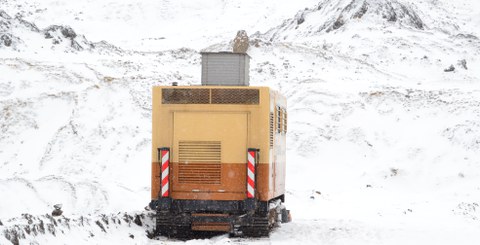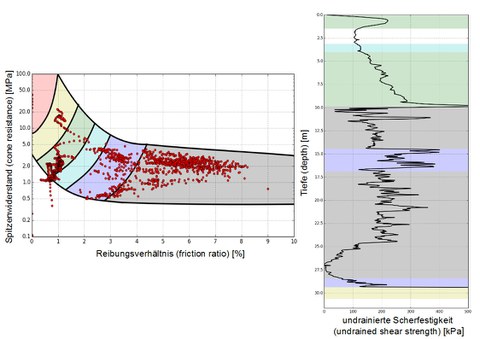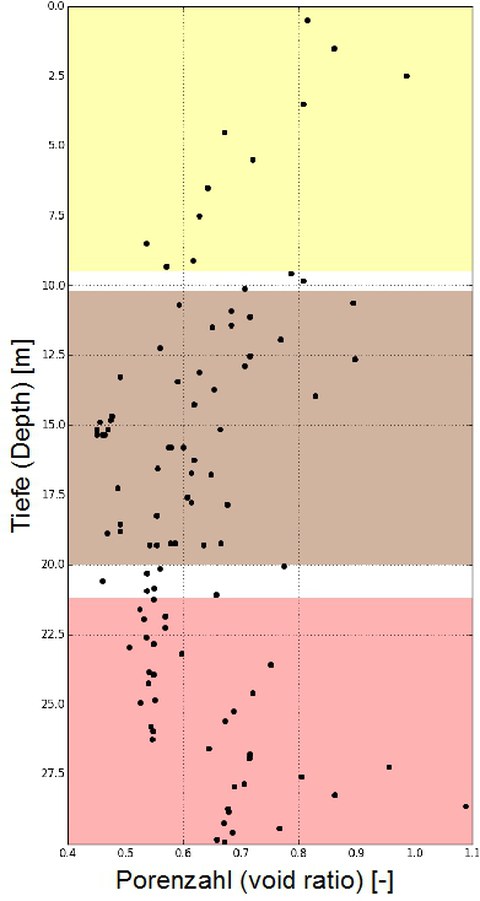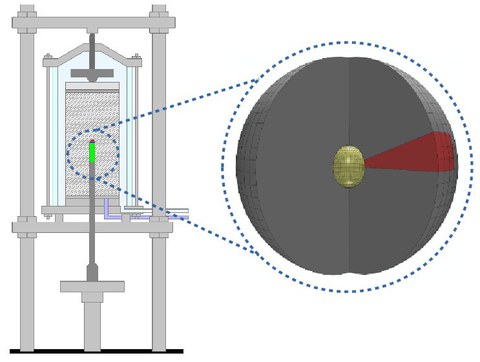Interpretation of Cone Penetration Tests
Cone penetration tests (CPTs) are commonly used field tests which provide a continuous image of the subsoil regarding the measured values of peak resistance and skin friction. Because of the rapid and relatively simple and inexpensive implementation, this soil survey method was selected to validate the prediction models for shear strength in dump slopes in open pit mines. However, some adjustments are needed for this application, as most empirical evaluations have been developed for natural soils and do not apply to dump soils. Therefore, in open pit mines calibration tests were performed consisting of the removal of a drill core and CPTs. In addition to the adaptation of the empirical evaluations, the extension of a semi-empirical evaluation method is carried out with the help of the theory of cavity expansion for fine-grained soils.
Furthermore, CPTs are evaluated regarding the prediction of shear strength and compared with the calibration factors obtained from the calibration experiments.

Caterpillar for cone penetration tests in an open pit mine
In order to calibrate the empirical evaluation of the undrained shear strength with cone penetration tests (CPT), CPTs were carried out in several open pit mines. At the same time, drill cores were sunken at the same positions. The drill cores were investigated in the soil mechanics laboratory of the TU Dresden regarding classification and strength properties. With the aid of statistical evaluations for the cone penetration tests, calibration factors were determined for very inhomogeneous soils.

Evaluation of a cone penetration test (soil type and undrained shear strength)

Results of laboratory tests from a drill core. Depiction of resulting soil layers (backround colors)
For the validation of different soil parameters, it is useful to control the boundary conditions in experimental setups (laboratory or in-situ). For field tests, e.g. the cone penetration test, this is very difficult or impossible. Therefore, model tests (primarily for coarse-grained soils) are carried out in the laboratory or on a test site. At the Institute of Geotechnical Engineering, small-scale CPTs on fine-grained soils were and are being realized. A specific test device was designed, with which a soil sample (see picture) can be passed through by a miniature pressure probe. In addition, different stress states can be applied to the soil sample. Thus, e.g. the influence of the stress level (equivalent to different depths) on the peak resistance and the surface friction can be investigated. The test results are used to validate the numerical cavity expansion but also to verify empirical evaluations.

Exploded view drawing of a pressure probe tip
When inducing the pressure probe tip into the ground, the soil is displaced. The numerical cavity expansion is a simplified model to depict this process. At the Institute of Geotechnical Engineering, research is carried out whether the cavity expansion can also be applied to fine-grained soils. For this purpose, miniature cone penetration tests conducted in the laboratory are recalculated with the numerical cavity expansion. The results, e.g. for the evolution of the peak resistance, are compared with each other. For the numerical calculations advanced constitutive models are used.

Model of the cavity expansion